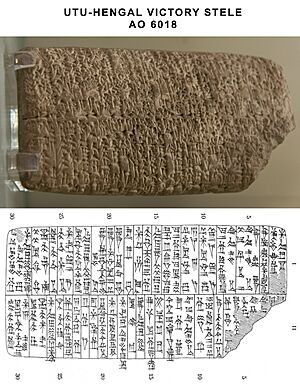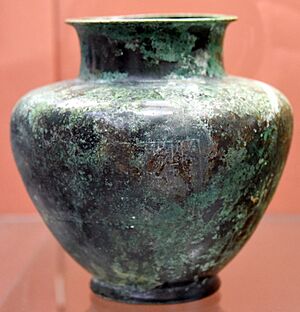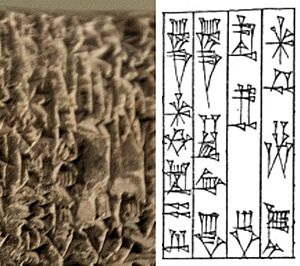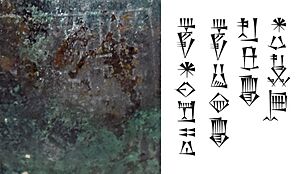Utu-hengal facts for kids
Quick facts for kids Utu-hengal |
|
|---|---|
| King of Uruk | |

Utu-Hegal, Prince of the Sumerian city of Uruk, praying for victory against the Gutian king Tirigan. 19th century illustration.
|
|
| Reign | c. 2119 BC – 2112 BC
c. 2055 BC – 2048 BC (Short Chronology) |
| Predecessor | Tirigan (Gutian Dynasty) Nam-mahani (Second Dynasty of Lagash) |
| Successor | Ur-Nammu (Third dynasty of Ur) |
| Dynasty | 5th Dynasty of Uruk |
Utu-hengal was an important king from ancient Sumer, a land in what is now modern-day Iraq. He became king after Sumer had been ruled by outsiders, first the Akkadians and then the Gutians, for about 200 years. Utu-hengal is famous for leading the Sumerian people to freedom from Gutian rule.
He was known as the "King of Uruk," a powerful city in Sumer. He is also seen as the founder of the "Fifth Dynasty of Uruk." His rule helped set the stage for a new golden age in Sumer, as his son-in-law, Ur-Nammu, later founded the powerful Third Dynasty of Ur.
Contents
Utu-hengal's Rise to Power
Utu-hengal's journey to becoming king is quite interesting. Many historians believe he was a governor in the city of Uruk. Around 2050 BC, he decided to rebel against the Gutian kings who controlled Sumer.
Defeating the Gutians
Utu-hengal gathered the cities of Sumer to fight against the last Gutian king, Tirigan. They had a big battle, and Utu-hengal won! King Tirigan had to run away from Sumer.
Tirigan tried to find safety in a city called Dubrum. But when the people of Dubrum heard that Utu-hengal was coming, they captured Tirigan and his family. They brought them to Utu-hengal, and Tirigan agreed to leave Sumer for good. This victory was a huge moment for the Sumerian people.
King of Sumer
After his great victory over the Gutians, Utu-hengal became the king of all Sumer. He was seen as a hero who brought freedom back to his people.
End of His Reign
Utu-hengal ruled for seven years. Sadly, he died in an accident while checking on a dam. After his death, his son-in-law, Ur-Nammu, who was the governor of the city of Ur, took over as king of Sumer.
Utu-hengal was the only king of the Fifth Dynasty of Uruk. However, the Sumerian people often saw his rule and the later Ur III dynasty as one continuous period. Utu-hengal is still remembered as one of the most important heroes in Sumerian history.
What His Titles Meant
On a special stone monument called a Victory Stele, Utu-hengal described himself with grand titles. He called himself:
- "Utu-hengal, the great man"
- "King of Uruk"
- "King of the four quarters of the world"
This last title meant he saw himself as the ruler of the entire known world at that time.
Important Inscriptions
We know a lot about Utu-hengal from various inscriptions he left behind. These are like ancient writings carved into stone or metal.
The Victory Stele

Utu-hengal had a special stone stele (a tall, carved stone slab) built in Uruk to celebrate his victory. A copy of this stele is now in the Louvre Museum in Paris.
The stele tells the story of how Utu-hengal defeated the Gutians and their king, Tirigan. It describes the Gutians as a "fanged snake" who had taken away Sumer's kingship and filled the land with trouble. It says that the god Enlil commanded Utu-hengal to bring Sumer back to its rightful rulers.
The inscription also explains how Tirigan and his family were captured and brought before Utu-hengal. It says that Utu-hengal made Tirigan lie at the feet of the god Utu and placed his foot on Tirigan's neck, showing his complete victory.
The Copper Vase

Another important item is a copper-alloy vase, which is now in the British Museum. This vase also has an inscription from Utu-hengal.
The inscription on the vase says: "This is Utu-hengal, Powerful male, King of Uruk, King of the four quarters." It also includes a warning, or a "curse," for anyone who might try to erase his name or remove the vase. It asks the gods to cut short their reign and wipe out their family. This shows how important it was to ancient kings that their names and achievements were remembered.
Stone Fragment
There is also a small piece of a stone monument, also in the British Museum, that mentions Utu-hengal's name and titles. It repeats the phrase: "Utu-hengal, the great man, King of Uruk, King of the four quarters of the world."
Images for kids






